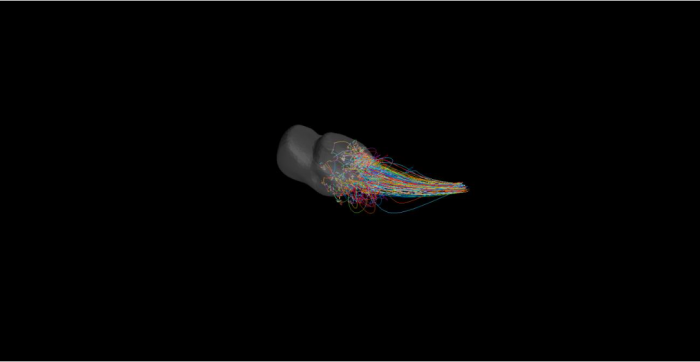
The in-situ exploration of small celestial bodies in our Solar System is the current frontier of space exploration. Among these objects, the Near Earth Asteroid (NEA) population is largely accessible to spacecraft, and reaching most NEAs is cheaper than reaching our Moon.
A further interesting subset is that of binary asteroids. These acquired increasing popularity since 1993, when the first natural satellite of an asteroid was discovered. At that time, NASA’s Galileo spacecraft imaged the asteroid moon Dactyl while performing a flyby near its bigger companion 243 Ida. In the last few decades, many multiple asteroid systems were discovered, and it is currently estimated that about 16% of NEA are binaries.
But why are asteroids important, and why should we care about them? The study of asteroids is relevant for a number of reasons. Primarily, it is motivated by a great scientific interest: these bodies are considered the building blocks of our planets and provide invaluable and unique insights on the birth and evolution of our Solar System.
The binary asteroid environment is the ideal place to study gravitational dynamics, to enhance the understanding of how celestial bodies in the Solar System were formed, and how they evolve. Binaries offer the unique opportunity to determine precisely asteroid masses and densities: nowadays, mass and density are accurately known only for a few tens of small body objects. In the case of binary systems, the mass of the asteroids can be accurately computed after the orbit of the satellite object is measured. From a space engineering and technological point of view, they represent ideal and affordable places for deep space In-Orbit-Demonstration (IOD) experiments.
Currently, studies are ongoing to investigate the feasibility of extracting mineral resources from asteroids. This is not only relevant to the growing community of asteroid miners but also to support future space travels. The abundance of water within particular classes of asteroids could make them serve as interplanetary fueling stations in the future. But asteroids are not only opportunities for the scientific and technological development: they also pose a concrete hazard to our cities and societal communities.
To properly address all these problems, it is of great importance to study the dynamical and physical properties of such objects. Currently, we mainly rely on remote surveys, which offer great but yet incomplete data about our neighbor asteroid population. Data must be therefore complemented using close-proximity and in-situ measurements.
Ongoing and currently-planned space missions to asteroids make use of small spacecraft and often employ very small probes to enhance science acquisition capabilities. These probes are typically released in the close proximity of the celestial body and usually have very low (or no) maneuvering capabilities. The release maneuver typically is performed such that the probe is injected directly to its nominal orbit or to a landing path towards the surface of the asteroid. When dealing with small spacecraft, the close-proximity exploration of asteroids and comets is among the latest challenges of modern astrodynamics.
Due to their peculiar and irregular mass distribution, the gravity field around such celestial bodies is characterized by an extremely nonlinear dynamical behavior. Also, due to the lack of precise data, large uncertainties exist and cannot be resolved within the design phase of the mission. The gravity field around the object is largely unknown and so are its shape and rotational dynamics. In such chaotic environments, the ballistic descent of the probe must be carefully designed to maximize the success rate of the release maneuver and avoid the loss of the probe, which can occur if missing the surface or bouncing off and escaping the weak attraction of the asteroid.
ESA’s HERA mission (formerly called AIM – Asteroid Impact Mission) is a joint collaboration with NASA’s DART (Double Asteroid Redirection Test) mission as part of the AIDA (Asteroid Impact and Deflection Assessment). The ultimate goal of AIDA is to assess the possibility to deflect the interplanetary trajectory of a binary asteroid by means of a high-speed kinetic impact on the smaller (secondary) asteroid. The impact provides a great opportunity to study the properties of the body before and after the impact and have information on its interior.

Simulation of ballistic landing trajectories with uncertainty at release
To this goal, one of the tasks of AIM was to scan the interior of the secondary by using a bi-static low-frequency radar, whose receiver was located on a small box to be released on the surface. It is then important to investigate design solutions for the ballistic landing of such a probe. The success rate is shown to be dramatically dependent on release conditions (both position and velocity). The most successful solutions are found when the release is performed in the proximity of the L2 point associated with the binary’s three-body problem, by exploiting manifold dynamics. In this case, the gravitational attraction of the primary asteroid is used to stabilize the ballistic descent and to reduce the chances of escaping the system after bouncing off the surface or missing the secondary asteroid.
These findings are described in the article entitled Ballistic landing design on binary asteroids: the AIM case study, recently published in the journal Advances in Space Research. The work focuses on ESA’s AIM case study, although the methods and analyses presented are general and applicable to any binary asteroid scenario. This work was conducted by Fabio Ferrari and Michèle Lavagna from the Politecnico di Milano.









